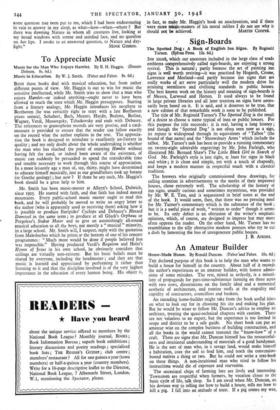Sign-Boards
INN SIGNS, which our ancestors included in the large class of trade emblems comprehensively called sign-boards, are enjoying a strong revival. This is natural ; partly because the art of painting inn signs is well worth reviving—it was practised by Hogarth, Crome, Lawrence and Morland—and partly because inn signs that are really works of art serve particularly well the modern drive for attaining seemliness and civilising standards in public houses. The best known work on the history and meaning of sign-boards is of Messrs, Larwood and Hotten. It used always to be found in large private libraries and all later treatises on signs have neces- sarily been based on it. It is said, and it deserves to be true, that a new edition of that remarkable work is soon to be published.
The title of Mr. Reginald Tumor's The Spotted Dog is the result of a desire to choose a name typical of inns or public houses. For this purpose the title succeeds: it is real, having a long history ; and though the ' Spotted Dog' is not often seen now as a sign, its repute is widespread through its equivalents of ' Talbot' (the hound of that name) and the ' Shrewsbury Arms' which include the talbot. Mr. Tumor's task has been to provide a running commentary on twenty-eight admirable engravings by Mr. John Farleigh, who illustrated Mr. Bernard Shaw's The Little Black Girl in Search of God. Mr. Farleigh's style is just right, at least for signs in black and white ; it is clean and simple, yet with a touch of rhapsody, and keeps a modern manner in respectful touch with a classical tradition.
The brewers who originally commissioned these drawings, for calling attention in advertisements to the merits of their improved houses, chose extremely well. The scholarship of the history of inn signs, usually curious and sometimes mysterious, was provided by Mr. W. E. Tate, and is sequestered in brief notes at the end of the book. It would seem, then, that there was no pressing need for Mr. Tumor's commentary which is the substance of the book ; but it is a useful piece of work, " written to order " though it seems to be. Its only defect is an obtrusion of the writer's emphatic opinions, which, of course, are designed to impress but may more often oppress the reader. On the other hand, Mr. Tumor has no resemblance to the silly obstructive modern poseurs who try to cut a dash by lamenting the loss of unregenerate public houses.
J. B. ATKINS.


































 Previous page
Previous page